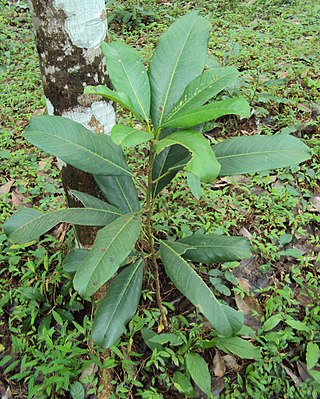
The Moraceae—often called the mulberry family or fig family—are a family of flowering plants comprising about 38 genera and over 1100 species. Most are widespread in tropical and subtropical regions, less so in temperate climates; however, their distribution is cosmopolitan overall. The only synapomorphy within the Moraceae is presence of laticifers and milky sap in all parenchymatous tissues, but generally useful field characters include two carpels sometimes with one reduced, compound inconspicuous flowers, and compound fruits. The family includes well-known plants such as the fig, banyan, breadfruit, jackfruit, mulberry, and Osage orange. The 'flowers' of Moraceae are often pseudanthia.

Broussonetia is a genus of four species of trees in the family Moraceae, native to eastern Asia. These four species have high-quality fiber which consist of more than 90% of cellulose. They are traditionally applied for various daily necessities in South Eastern Asia and papermaking in East Asia.

Streblus is a genus of flowering plants in the mulberry family, Moraceae. It includes five species native to the Indian subcontinent, Indochina, southern China, and Malesia.

Dorstenia is a genus within the mulberry family, Moraceae. Depending on the author, there are said to be 100 to 170 species within this genus, second only in number to the genus Ficus within Moraceae. Plants of the World Online currently accepts 122 species. Dorstenia species are mainly known for their unusual inflorescences and growth habits. Dorstenia is named in honor of the German physician and botanist Theodor Dorsten (1492–1552). The type species is Dorstenia contrajerva.
Artocarpus rigidus is a tree species in the Moraceae that was described by Blume. A. rigidus is a wild species of the breadfruit/jackfruit genus (Artocarpus) and may be referred to as monkey jack. Its Vietnamese name is mít nài.
Ficus simplicissima is an Asian species of fig tree in the family Moraceae. This species is similar to Ficus triloba and synonyms include Ficus hirta; its native range is Nepal to southern China and Indo-China, Sumatra and Java.
Ficus costata is an Asian species of fig tree in the family Moraceae. No subspecies are listed in the Catalogue of Life its native range is SW. India, Sri Lanka, Indo-China. The species can be found in Vietnam: where it may be called sung sóng.

Ficus glaberrima is an Asian species of fig tree in the family Moraceae. The native range of this species is India, S. China and tropical Asia: Indo-China to the Lesser Sunda Islands. The species can be found in Vietnam: where it may be called đa trụi or đa lá xanh.

Ficus kurzii may be called the Burmese banyan: it is an Asian species of fig tree in the family Moraceae. No subspecies are listed in the Catalogue of Life; its native range is China (Yunnan) Indo-China and Malesia. The species can be found in Vietnam: where it may be called Ða Kurz.
Ficus sumatrana is an Asian species of fig tree in the family Moraceae. No subspecies are listed in the Catalogue of Life; its native range is Indo-China to Malesia.

Ficus fistulosa is an Asian species of fig tree in the family Moraceae. No subspecies are listed in the Catalogue of Life; its native range is Assam to Taiwan, Indo-China, Malesia and New Guinea. The species can be found in Vietnam: where it may be called sung giòn. It is dioecious, with male and female flowers produced on separate individuals.

Ficus callosa is an Asian species of fig tree in the family Moraceae. No subspecies are listed in the Catalogue of Life; the native range of this species is India, southern China, Indo-China and Malesia. The species can be found in Vietnam: where it may be called đa chai or đa gùa.

Ficus rumphii is a banyan fig species in the family Moraceae. No subspecies are listed in the Catalogue of Life. The species can be found in: India, southern China, Indo-China and Malesia. In Vietnam it may be called lâm vồ or đa mít.
Ficus consociata is a banyan fig species in the family Moraceae. No subspecies are listed in the Catalogue of Life. The species can be found in Indo-China and western Malesia. In Vietnam it may be called đa đồng hành.

Ficus trichocarpa is a climbing fig species, in the family Moraceae, which can be found in Bangladesh, Indo-China and Malesia. In Vietnam it may be called sung tà.

Ficus heterophylla is a fig plant species, in the family Moraceae, which can be found in India, southern China, Indo-China and western Malesia. In Vietnam it may be called vú bò.

Ficus sagittata is a trailing fig species, in the family Moraceae, which can be found in southern China, Indo-China and Malesia. In Vietnam it may be called sung dầu tên or sung bò. No subspecies are listed in the Catalogue of Life.
Ficus capillipes is an Asian species of fig tree in the family Moraceae. No subspecies are listed in the Catalogue of Life; the native range of this species is Indo-China and Sumatra. The species can be found in Vietnam: where it may be called ''đa cuống mãnh.

Ficus fulva is a fig species in the family Moraceae. No subspecies are recorded and the native range of this species is from Bangladesh to Indo-China and throughout Malesia. The species can be found in Vietnam: where it may be called ngái vàng, ngái lông, or vả. Ficus fulva is dioecious, with male and female flowers produced on separate individuals.
Taxotrophis is a genus of flowering plants in the mulberry family, Moraceae. It includes six species native to tropical Asia and New Guinea, ranging from the Indian subcontinent through Indochina, southern China, and Malesia to New Guinea.












